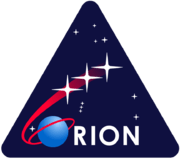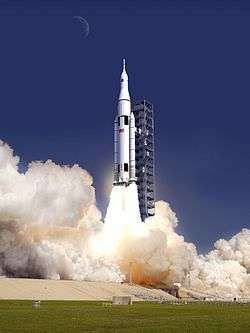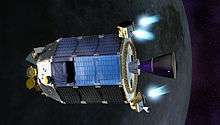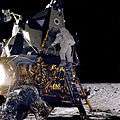Exploration Mission 1
 Artist concept of SLS Block 1 configuration on launchpad | |||||
| Operator | NASA/ESA | ||||
|---|---|---|---|---|---|
| Mission duration | 1 month | ||||
| Spacecraft properties | |||||
| Spacecraft type | Orion MPCV | ||||
| Start of mission | |||||
| Launch date | September 2018[1] | ||||
| Rocket | SLS Block 1[2] | ||||
| Launch site | Kennedy LC-39B[3] | ||||
| End of mission | |||||
| Landing date | October 2018 | ||||
| Landing site | Pacific Ocean[4] | ||||
| Orbital parameters | |||||
| Reference system | Selenocentric | ||||
| Moon orbiter | |||||
| Orbital insertion | October 2018 | ||||

| |||||
Exploration Mission 1 or EM-1 (previously known as Space Launch System 1 or SLS-1) is the first planned flight of the Space Launch System and the second uncrewed test flight of the Orion Multi-Purpose Crew Vehicle. The launch is planned for September 30, 2018 from Launch Complex 39B at the Kennedy Space Center. The Orion spacecraft is planned to spend approximately 3 weeks in space, with 6 days of this in a retrograde orbit around the Moon.[5] It is planned to be followed by Exploration Mission 2 in 2023.
Overview
The Block 1 version of SLS used on this mission will consist of two five-segment Solid Rocket Boosters, four RS-25D engines built for the Space Shuttle program and an Interim Cryogenic Propulsion Stage.[6] EM-1 is intended to demonstrate the integrated spacecraft systems prior to a crewed flight, and in addition, test a high speed reentry (11 km/s) on Orion's thermal protection system.[6]
On January 16, 2013, NASA announced that the European Space Agency would build Orion's service module based on its Automated Transfer Vehicle, so the flight could also be regarded as a test of ESA hardware as well as American, and of how the ESA components interact with the American Orion components.[7]
The Exploration Flight Test 1 (EFT-1) flight article was consciously constructed in a way that if all the missing components (seats, life support systems) were added, it would not meet the mass target. It was planned that subsequent capsules would be modified to be lighter, based on manufacturing experience.
In January 2015 NASA and Lockheed announced that some components in the EM-1 capsule would be up to 25 percent lighter compared to the previous one. This would be achieved by changes to the primary structure - the EM-1 article would be welded together from 3 panels for the cone, as opposed to 6 panels used for the EFT-1 article. The total number of welds was reduced from 19 to 7,[8] thus saving the additional mass of the weld material. Other savings would be due to revisiting its various components and wiring. For EM-1 the capsule will be outfitted with complete life support system and crew seats, but will be left unmanned.[9]
History
Originally EM-1 was planned to follow a circumlunar trajectory without entering orbit around the Moon. [3][6]
Secondary payloads

Thirteen low-cost CubeSat missions are to be selected as secondary payloads on the EM-1 test flight.[10] They will reside within the second stage on the launch vehicle from which they will be deployed. Two CubeSats have been selected through NASA's Next Space Technologies for Exploration Partnership, three through the Human Exploration and Operations Mission Directorate, and two through the Science Mission Directorate. The remaining CubeSats are to be chosen in 2017 through NASA's Cube Quest challenge, or by submission from NASA's international partners. The spacecraft already selected are:[11][12]
- Lunar Flashlight is a spacecraft that will determine the presence or absence of exposed water ice, and map its concentration at the 1-2 kilometer scale within the permanently shadowed regions of the lunar south pole.[13][14]
- Near-Earth Asteroid Scout is proof-of-concept of a controllable CubeSat solar sail spacecraft capable of encountering near-Earth asteroids (NEA).[15] Observations will be achieved through a close (≈10 km) flyby and using a high resolution science-grade monochromatic camera to measure the physical properties of a near-Earth asteroid, helping inform the future Asteroid Redirect Mission.[15] A variety of potential targets would be identified based upon launch date, time of flight, and rendezvous velocity.
- BioSentinel is an astrobiology mission that will use yeast to detect, measure, and compare the impact of deep space radiation on living organisms over long durations beyond low-Earth orbit.[12]
- SkyFire is a spacecraft designed by Lockheed Martin to fly by the Moon.
- Lunar IceCube, designed by Morehead State University, will search for evidence of water ice in a low lunar orbit.
- CuSP (CubeSat for Solar Particles) will be one of the first CubeSats to enter interplanetary space. It is designed to study the dynamic particles and magnetic fields that stream from the Sun[16] and as a proof of concept for the feasibility of a network of stations to track space weather.
- Lunar Polar Hydrogen Mapper (LunaH-Map) will map hydrogen within craters near the lunar south pole, tracking depth and distribution of hydrogen-rich compounds like water. It will use a neutron detector to measure the energies of neutrons that interacted with material in the lunar surface. Its mission is planned to last 60 days and perform 141 orbits of the Moon.[17]
NASA awarded two CubeSat contracts in March 2015 to Lockheed Martin ($1.4 million) and Morehead State University ($7.9 million) to develop SkyFire and Lunar IceCube, respectively, that could potentially be added to the EM-1 test flight.[18][19] The remaining six of the eleven SLS launch slots will be filled through a competition pitting CubeSat teams based in the United States against each other in a series of ground tournaments called 'NASA's Cube Quest Challenge'.[19][20] The remaining winners will be announced at the completion of the fourth and final Ground Tournament in February 2017.[21] This competition will contribute to opening deep space exploration to non-government spacecraft.
Predecessors
Apollo 8 was a similar mission in 1968, crewed by 3 astronauts, designed to flight test a Command Service Module beyond low Earth orbit. It made use of its Service Module engine three times, to enter and leave lunar orbit.
Gallery
 Orion Exploration Mission-1 Animation
Orion Exploration Mission-1 Animation Artist's rendering of the launch of EM-1
Artist's rendering of the launch of EM-1 EM-1's orbital path
EM-1's orbital path EM-1 Welding sequence
EM-1 Welding sequence Completed EM-1 Orion weld structure
Completed EM-1 Orion weld structure
References
- ↑ Exploration Mission 1: SLS and Orion mission to the Moon outlined, Chris Bergin, 29 February 2012
- ↑ Bergin, Chris (23 February 2012). "Acronyms to Ascent – SLS managers create development milestone roadmap". NASASpaceflight.com. Retrieved 14 July 2012.
- 1 2 Hill, Bill (March 2012). "Exploration Systems Development Status" (PDF). NASA Advisory Council. Retrieved 21 July 2012.
- ↑ Bergin, Chris (14 June 2012). "NASA teams evaluating ISS-built Exploration Platform roadmap". NASASpaceflight.com. Retrieved 21 July 2012.
- ↑ "The Ins and Outs of NASA's First Launch of SLS and Orion". NASA. 27 Nov 2015. Retrieved 3 May 2016.
- 1 2 3 Singer, Jody (25 April 2012). "Status of NASA's Space Launch System" (PDF). NASA Marshall Space Flight Center. Retrieved 5 August 2012.
- ↑ "Engineers resolve Orion will 'lose weight' in 2015". NASA. 2013-01-16. Retrieved 2013-03-22.
- ↑ "Orion program manager talks EFT-1 in Huntsville". ABC - WAAY 31. 13 January 2015. Retrieved 15 January 2015.
- ↑ "Acronyms to Ascent – SLS managers create development milestone roadmap". Waff. 13 January 2015. Retrieved 15 January 2015.
- ↑ Healy, Angel (February 4, 2016). "Boeing-Built Rocket to Carry Lockheed Martin's Skyfire CubeSat". GovConWire. Retrieved 2016-02-05.
- ↑ Hambleton, Kathryn. "NASA Space Launch System's First Flight to Send Small Sci-Tech Satellites Into Space". nasa.gov. Retrieved 2016-02-03.
- 1 2 Zolfagharifard, Ellie (3 April 2015). "An asteroid hunter, lunar flashlight and DNA kit: Nasa reveals experiments its mega rocket will carry on its first test flight". Daily Mail. London. Retrieved 2015-05-24.
- ↑ "Lunar Flashlight". Solar System Exploration Research Virtual Institute. NASA. 2015. Retrieved 2015-05-23.
- ↑ Wall, Mike (9 October 2014). "NASA Is Studying How to Mine the Moon for Water". Space.com. Retrieved 2015-05-23.
- 1 2 McNutt, Leslie; Castillo-Rogez, Julie (2014). "Near-Earth Asteroid Scout" (PDF). NASA. American Institute of Aeronautics and Astronautics. Retrieved 2015-05-13.
- ↑ "Heliophysics CubeSat to Launch on NASAs SLS". NASA. February 2, 2016. Retrieved 2016-02-05.
- ↑ Harbaugh, Jennifer. "LunaH-Map: University-Built CubeSat to Map Water-Ice on the Moon". nasa.gov. nasa.gov. Retrieved 10 February 2016.
- ↑ Morring, Frank (24 April 2015). "Habitats Could Be NASA's Next Commercial Spacecraft Buy". Aviation Week. Retrieved 2015-05-26.
- 1 2 Clark, Stephen (8 April 2015). "NASA adding to list of CubeSats flying on first SLS mission". Spaceflight Now. Retrieved 2015-05-25.
- ↑ Steitz, David E. (24 November 2014). "NASA Opens Cube Quest Challenge for Largest-Ever Prize of $5 Million". NASA News. Retrieved 2015-05-27.
- ↑ NASA Awards Second-Round Prizes in Cube Quest Challenge. March 21, 2016.

